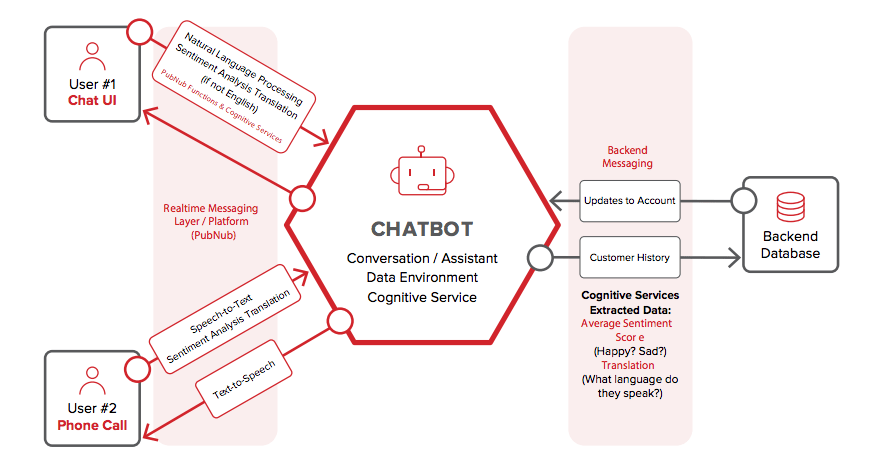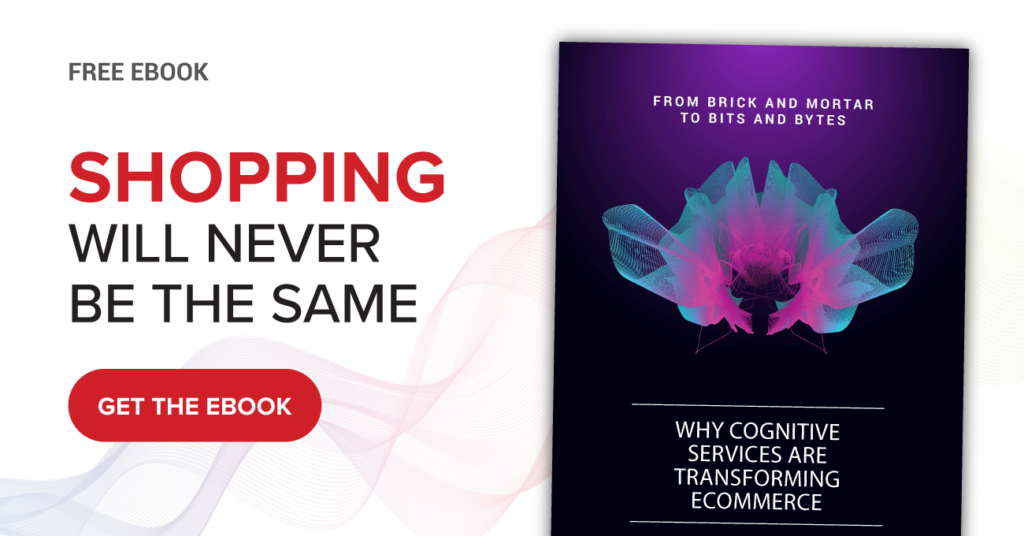IN THIS ARTICLE
Subscribe to Our Newsletter
Cognitive services is a broad term for machine learning, artificial intelligence, and distributed algorithms that empower you to integrate vision, speech, language, knowledge, problem solving, analysis, categorization, moderation, and more into your apps and businesses.
In a nutshell, cognitive services augment and expand human capabilities, allowing us to do our jobs faster, more efficiently, and more sustainably.
And luckily for us, we’re seeing a massive number of cognitive services enter the market, from the big players like Watson, AWS, and Microsoft, to fast-moving startups like SiftNinja and Clarifai. And they’ve made these services available as discrete components through APIs that make it a snap for developers to fold them into new applications.
Examples of Cognitive Services
- Translation: Enable two users to chat in their own – different! – languages by translating their messages in realtime.
- Natural Language Processing: Analyze massive amounts of data inputs and gauge the sentiment of the messages.
- Chatbots: Create an intelligent bot that parses natural language from a human and responds as accurately as another human could.
- Facial Recognition: Detect human faces and organize them into groups based on predetermined categories.
- Machine Learning: Intelligently sense, process and act on information delivered by sensors to control devices in response to environmental factors like temperature, rain, or earthquakes.
eCommerce Transformed: Cognitive Service Implementations
Cognitive services are the technology that’s transforming how we build apps, and ushering in a new era of interactivity and engagement. One of the areas with the biggest opportunity for transformation is eCommerce, and we’re already seeing cognitive services make a massive impact across a wide variety of uses.
Natural Language Processing ➤ Chatbots and Shopping Assistants
Natural language processing (NLP) is one of the core tenets of chatbots and shopping assistants that continue to pop up. NLP technology enables an AI to understand and respond to natural language. Rule-based chatbots, literally ones that respond to established questions, are easy to build. But is that really a smart bot?
Think for a moment. How many possible ways could a shopper ask for a recommendation on what blazer to buy? The AI needs to be able to use context to determine what the shopper is looking for, and give a recommendation accordingly. This requires a combination of NLP and machine learning to mimic a real-life helpful conversation.
The good news for any business looking to build chatbots is that there is a wide-variety of service providers that deliver the technology for you. They supply the base technology, and you train and implement the chatbot accordingly. Watson Assistant, Amazon Lex, and Microsoft Bot Framework are examples of services providing the technology you need to quickly train and deploy bots across your business.
Knowledge/Discovery ➤ Trends, Recommendations and Predictability
It has been estimated that Amazon’s recommendation engine drives 35% of total sales.
eCommerce creates a massive amount of data. Buyer personal information, behavior, how they found your website, and more. Manually making sense of this data is a challenge, and only grows more complex as more data is created. Knowledge and discovery services analyze and map large sets of data to create insights and unlock value in datasets to deliver answers, trends, and patterns within them. Trends and predictability go hand in hand. By extracting and understanding trends, you can make more educated predictions on what trends will come next. For eCommerce, this gives you an advantage in both understanding your own space and the competition, and gives you a baseline for changes to how you interact with your customers.
Equally important is building a recommendation engine to deliver relevant products and services to users who might be interested based on previous activities. Beyond just related items to prior purchases, cognitive services allow you to pull in as many collections of data as you want – location, demographics, age, and more – allowing you to supply recommendations based on those as well. Combined with trends and predictability, recommendations are an incredibly powerful way to increase conversions and engage a wider audience.
Language Translation ➤ Global Reach
95% of the online content that companies generate is available in only one language.
Language translation, allowing you to instantly convert text and spoken language to any other language instantaneously, is breaking the barrier of language across the web. In the past, it cost a fortune to manually translate an entire website to multiple languages, and, whenever changes were made, the entire site would need to be retranslated. It simply didn’t scale, making it hard for businesses to connect with a global audience.
There are a number of benefits to adding translation to your eCommerce website:
- Reach global audiences with low investment. Translate to multiple languages, and see which regions are interested before investing heavily in those markets.
- Translate user-generated content – customer and product reviews.
- Build a global call center, allowing your agents and your customers to speak in their native language.
- Analyze big data sets in multiple languages to a single source.
Data Enrichment ➤ Sales Cycle Optimization
Even companies on the cutting-edge, who are collecting massive amounts of data, run into issues with how they utilize that data. One of the biggest challenges to solve is ‘data silos,’ where data collected by one part of the business is kept separate from other parts, intentionally or unintentionally.
Data enrichment services tear down the silos to collect, organize, synthesize, and deliver insights on the massive sets of data. This is where cognitive services are a massive advantage to traditional BI – able to draw conclusions from a breadth of data, find the insights in the relationships between different sets of data, and help eCommerce companies optimize their decision making.
In a sales cycle, data enrichment can bring together customer conversations, marketing activities, backend metrics like time-to-close, and demographics, and break them down into understandable insights.
An Architecture Example: Shopping Assistant Chatbot
To build a shopping assistant chatbot, you need to deliver three things:
- The voice: The voice enables our chatbot to talk, retrieving information and making informed decisions via the brain, and delivering it verbally or through text in a natural, human-like manner.
- The brain: The brain is the command center for our chatbot, where we analyze and process data, use our memory to retrieve information we already have stored, and control our voice to have interactions.
- The memory: The memory is where we store all the information we need, from prior interactions to business logic, so the brain can make more informed decisions.
In more technical terms, the voice is powered by a realtime messaging layer, the brain is powered by cognitive services, and the memory is the backend database. The real magic happens between the realtime messaging layer and the cognitive services.
Serverless compute is the key for the two technologies to work seamlessly together. With serverless compute, the cognitive services can run directly in the realtime messaging layer, rather than via an external server, so interactions are fast and efficient. This is what creates a natural, lifelike conversation with the end user, and allows the chatbot to run a number of cognitive services simultaneously (sentiment analysis, translation, etc), all in realtime.

So, in this specific example, the eCommerce company has launched a chatbot that accepts both text chat and voice chat via phone. The realtime messaging layer (PubNub Realtime Messaging) between the chat UI/phone service run a number of cognitive services (IBM Watson’s suite of cognitive APIs) within their data stream channel, the communication pipeline, via PubNub Functions.
Cognitive services are integrated directly into messaging channels via PubNub Functions. Each cognitive service is a pre-built ‘BLOCK’ that runs on Functions, and BLOCKS can be dropped into messaging channels to run the cognitive service. Because it runs on serverless Functions, there’s no need for any 3rd party servers. All computation happens in the network.
For the text chat (User #1), natural language processing gauges the sentiment of the user’s messages to better understand if they’re happy, neutral, or angry, and language translation to determine what language the user is speaking, and translate it accordingly.
For voice chat over the phone (User #2), the messaging layer converts the spoken words into text with speech-to-text, then runs the same cognitive services as the aforementioned text chat.
From there, the chatbot, which uses a chatbot cognitive service, Watson Assistant, receives the processed chat messages, creates an informed response based on the context of the messages, and returns the response. It also writes any account updates to the backend database or triggers an action (like initiating a return). Combining these multiple cognitive services allows the chatbot to have any number of simultaneous conversations in realtime.
Looking Forward
Cognitive services will continue to innovate how eCommerce companies expand their markets and build better experiences for their customers. Businesses at the forefront of implementing cognitive services will yield more efficient buying cycles for customers, and have better insights to make data-driven decisions.
Even better, cognitive services have never been more accessible. Delivered through powerful APIs, cognitive service providers train, deliver and scale the powerful functionality so you can just focus on implementation. Whether you’re on a team of one or a thousand, these API-driven services help you build next-generation intelligence directly into your app quickly and easily.
Want in-depth analysis? Check out our full eBook From Brick and Mortar to Bits and Bytes: Why Cognitive Services are Transforming eCommerce.










